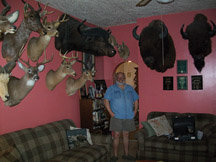Lifelong Union City resident John Janelli has been preserving and mounting animals since his middle school and Emerson High School years. He currently works in his home shop in Union City on Central Avenue.
Janelli is renowned throughout the world as a knowledgeable practitioner, and is the National Taxidermist Association’s conservation committee chairman.
‘Taxidermy is practiced by many but mastered by a few.’ – John Janelli
____________
The National Association of Taxidermy trains taxidermists and oversees their work, and gives back to the community through fundraisers and scholarships.
Childhood curiosity
“[High school teacher] Barbara Strobert, and [other] teachers, and even [former Mayor] Bill Musto took me seriously when I was doing these things,” said Janelli last week. “He always told me how proud he was to have a taxidermist coming up in Union City. But Mrs. Barbara Strobert got me on a work-study program at the Museum of Natural History, Monday, Wednesday, and Friday. She gave me three dollars a day – this is then – for bus fare, subway fare, and lunch. She hooked me up with some people back then that are still in my life today.”
Jannelli did work-study at [the museum] until his senior year. Then he met a taxidermist in West New York named John Morris.
“I did not get any technical training until joining the National Taxidermist Association, which was formed in 1971. I was the youngest member back then when I was 15. Now I am vice president.”
Janelli is the only licensed USDA taxidermist in the state of New Jersey.
“Everything comes through me, like JFK Airport [shipments of animal skins],” he says. “And once we handle that, it goes to a tannery. Tanning is a chemical process by which a raw, fresh animal skin is chemically treated and continually worked into workable leather. A complete different tannery is used if the skin will be used for clothing, jewelry and any other accessory.”
In his 40 years he has mounted creatures that used to be legal to hunt, but are not legal to hunt today, like jaguars, cheetahs, and tigers.
“We used to take in 20 tigers a week where I used to work,” he says. “We had two species of rhino back then, the black rhino, which is endangered today, and the white rhino. But because of our conservation efforts we have turned it into a sustainable wildlife resource. What I mean by that is that only a select few, the herd bull, once they reach a certain age where they no longer breed, those are the ones singled out in safari and taken by the hunter.”
He says due to the Endangered Species Act and the Marine Mammal Act, taxidermists cannot legally mount any marine animal.
“We are talking about the sea otter, the walrus, the polar bears, and seals,” Janelli said. “I’ve mounted polar bear, walrus, and sea otter back in the ’60 and ’70s because it was legal to do.”
On cable show
Janelli was on location for a week with the History Channel show “Mounted in Alaska,” which is about a taxidermy shop. On the program, he showed off his taxidermist kit that once belonged to Theodore Roosevelt, 26th president of the United States. Roosevelt was an avid supporter of nature and parks. Janelli also had his passenger pigeon mounts restored at the shop after years of wear and tear.
The episode, titled “Teddy Bear,” was scheduled to air on the History Channel on June 23.
Janelli talks at local and overseas seminars. “At my seminars I can have a person work with a squirrel or pigeon and mount it in a day into a lifelike pose,” he said, “with a thorough understanding of how it is done.”
He added, “I still use the stuff I was taught with. I like my mounts being one-of-a-kind.”
A mount is a frame of an animal body on which the skin of the animal is arranged. “You can’t get a one-of-a-kind mount when you use uniform mounts,” he said. “I like making my own material.”
Always writing
Janelli is writing his own book, having also written numerous articles throughout the years.
“I have always been writing because it is my passion,” said Janelli. “I mainly write for the National Taxidermist Association. Taxidermy is practiced by many but mastered by a few. I myself am not a master taxidermist any more than my mother is a master chef, yet I defy anyone to make a better Italian dish than my mother, bar none!”
After so many years in the business, Janelli is very adamant about one day having taxidermy implemented in some schools for interested students, since he was always supported as a young man by his teachers and local politicians.
“My ultimate goal is for someday my telephone to ring and have someone on the other line say, ‘John, this is [Mayor] Brian Stack. I’d like you to be the official [Union City] taxidermist representative to me on behalf of the taxidermists in New Jersey.’ That is my goal, because then I can give back to my mayor, and my former school teachers will know all those years from point A to point B [went] to make taxidermy more [comprehensible] to the people as a more viable science and art.”
If a kid is interested in a taxidermy career, John recommends they take courses in wild life biology, art and design, and sculpting.
Santo Sanabria may be reached at SSanabria@hudsonreporter.com.
